Uplink Transmit Power Control for Single-Carrier Grouped FDMA with Iterative Multiuser Detection
Abstract
:1. Introduction
- A specific power control algorithm that exploits the non-orthogonal structure of SC-GFDMA is designed to increase the available spectral efficiency in each chunk.
- Based on the SNR-variance density evolution, we provide a tractable analysis of SINR of users during the IMD.
- The proposed power control significantly increases the spectral efficiency in each chunk.
- The proposed power control efficiently reduces (transmit) power consumption at each chunk compared with the conventional SC-GFDMA schemes without power control.
2. System Model
2.1. Transmitter and Receiver Principles for Data Plane
2.2. SNR-Variance Density Evolution
2.3. Problem Formulation
3. Proposed Power Control for SC-GFDMA
3.1. SINR Analysis for Power Control
- If , for some constant C, then imposing a geometric sequence for the values of (e.g., ) is sufficient to ensure (48) for all .
- Suppose it is possible to conversely prove the statement: there always exists a constant C for which is true for all , as long as is a geometric sequence with respect to k. Then, from the first observation, we can argue that there exists a geometric sequence with an appropriate common ratio (possibly ) that guarantees our criterion for the power control given in (47) or (48).
3.2. Proposed Power Control Algorithm
- Define .If, set and updateelse update user set:
- If, update and go to Step 2-1)else go to Step 3.
3.3. Appropriate Value of
4. Simulation Results and Discussion
4.1. Simulation Setup
4.2. Spectral Efficiency Enhancement
4.3. Transmit Power Saving
4.4. Computational Complexity
5. Conclusions
Future Work
Author Contributions
Funding
Conflicts of Interest
References
- Pancaldi, F.; Vitetta, G.M.; Al-Dhahir, N.; Uysal, M.; Muhaidat, S.; Kalbasi, R. Single-Carrier Frequency Domain Equalization: A Review. IEEE Signal Process. Mag. 2008, 25, 37–56. [Google Scholar] [CrossRef]
- Ekstrom, H.; Furuskar, A.; Karlsson, J.; Meyer, M.; Parkvall, S.; Torsner, J.; Wahlqvist, M. Technical solutions for the 3G long-term evolution. IEEE Commun. Mag. 2006, 44, 38–45. [Google Scholar] [CrossRef]
- Falconer, D.; Ariyavisitakul, S.; Benyamin-Seeyar, A.; Eidson, B. Frequency Domain Equalization for Single-carrier Broadband Wireless Systems. IEEE Commun. Mag. 2002, 40, 58–66. [Google Scholar] [CrossRef] [Green Version]
- Myung, H.G.; Lim, J.; Goodman, D.J. Single Carrier FDMA for Uplink Wireless Transmission. IEEE Veh. Technol. Mag. 2006, 3, 30–38. [Google Scholar] [CrossRef]
- Yune, T.W.; Choi, C.H.; Im, G.H.; Lim, J.B.; Kim, E.S.; Cheong, Y.C.; Kim, K.H. SC-FDMA with iterative multiuser detection: improvements on power/spectral efficiency. IEEE Commun. Mag. 2010, 48, 164–171. [Google Scholar] [CrossRef]
- Lim, J.B.; Choi, C.H.; Yune, T.W.; Im, G.H. Iterative multiuser detection for single-carrier modulation with frequency-domain equalization. IEEE Commun. Lett. 2007, 11, 471–473. [Google Scholar] [CrossRef]
- Choi, C.H.; Lim, H.J.; Kim, T.K.; Im, G.H.; Lawrence, V.B. Spectral efficient multiuser technique with channel-dependent resource allocation schemes. IEEE Trans. Wirel. Commun. 2012, 11, 990–999. [Google Scholar] [CrossRef]
- 3GPP Technical Specification Group Radio Access Network; Evolved Universal Terrestrial Radio Access (E-UTRA). Physical Channels and Modulation (Release 15); 3GPP TS 36.211 V15.4.0; 3GPP: Paris, France, 2018; Available online: http://www.3gpp.org (accessed on 18 December 2019).
- 3GPP Technical Specification Group Radio Access Network; Evolved Universal Terrestrial Radio Access (E-UTRA). Physical Layer Procedures (Release 15); 3GPP TS 36.213 V15.4.0; 3GPP: Paris, France, 2018; Available online: http://www.3gpp.org (accessed on 18 December 2019).
- Khamidehi, B.; Sabbaghian, M. Resource Allocation for SC-FDMA Femtocell Networks. IEEE Trans. Veh. Technol. 2019, 68, 4573–4585. [Google Scholar] [CrossRef]
- Ali, S.; Ahmad, A.; Iqbal, R.; Saleem, S.; Umer, T. Joint RRH-Association, Sub-Channel Assignment and Power Allocation in Multi-Tier 5G C-Rans. IEEE Access 2018, 6, 34393–34402. [Google Scholar] [CrossRef]
- Ng, B.K.; Choi, T.; Lam, C.T. Performance of SC-FDMA-based multiuser massive MIMO system in the presence of phase noise. In Proceedings of the 2017 IEEE 17th International Conference on Communication Technology (ICCT), Chengdu, China, 27–30 October 2017. [Google Scholar]
- Lu, X.; Ni, Q.; Zhao, D.; Cheng, W.; Zhang, H. Resource virtualization for customized delay- bounded QoS provisioning in uplink VMIMO-SC-FDMA systems. IEEE Trans. Commun. 2019, 67, 2951–2967. [Google Scholar] [CrossRef]
- Lu, X.; Yang, K.; Fan, N.; Guo, H.; Zhang, H. Joint clustering of users and resources for multi-cell VMIMO-SC-FDMA uplink systems. IEEE Trans. Veh. Technol. 2019, 68, 1417–1430. [Google Scholar] [CrossRef]
- Hu, Y.; Wang, F.; Lu, J. Low PAPR Filter Bank Single Carrier for 5G mMTC. IEEE Internet Things J. 2019, 6, 6887–6895. [Google Scholar] [CrossRef]
- Ghavimi, F.; Lu, Y.W.; Chen, H.H. Uplink scheduling and power allocation for M2M communications in SC-FDMA-based LTE-A networks with QoS guarantees. IEEE Trans. Veh. Technol. 2017, 66, 6160–6170. [Google Scholar] [CrossRef]
- Bao, P.; Guan, Q.; Guan, M. A multiuser detection algorithm in the uplink SC-FDMA system for green communication network. IEEE Access 2019, 4, 5982–5989. [Google Scholar] [CrossRef]
- Kaligineedi, P.; Bhargava, V.K. Frequency-domain turbo equalization and multiuser detection for DS-UWB systems. IEEE Trans. Wirel. Commun. 2008, 7, 3280–3284. [Google Scholar] [CrossRef]
- Lunttila, T.; Lindholm, J.; Pajukoski, K.; Tiirola, E.; Toskala, A. EUTRAN uplink performance. In Proceedings of the 2007 2nd International Symposium on Wireless Pervasive Computing, San Juan, Puerto Rico, 5–7 February 2007. [Google Scholar]
- Wong, I.C.; Oteri, O.; McCoy, W. Optimal resource allocation in uplink SC-FDMA systems. IEEE Trans. Wirel. Commun. 2009, 8, 2161–2165. [Google Scholar] [CrossRef]
- Triantafyllopoulou, D.; Kollias, K.; Moessner, K. QoS and energy efficient resource allocation in uplink SC-FDMA systems. IEEE Trans. Wirel. Commun. 2015, 14, 3033–3045. [Google Scholar] [CrossRef] [Green Version]
- Zhang, X.; Shen, X.; Xie, L. Uplink achievable rate and power allocation in cooperative LTE-advanced networks. IEEE Trans. Veh. Technol. 2016, 65, 2196–2207. [Google Scholar] [CrossRef]
- Cho, Y.S.; Kim, D.; Kim, T.K.; Im, G.H. Improved channel-dependent user selection for an SC-FDMA system. IEEE Commun. Lett. 2012, 16, 1608–1611. [Google Scholar]
- Shah, S.T.; Gu, J.; Hasan, S.F.; Chung, M.Y. SC-FDMA-Based resource allocation and power control scheme for D2D communication using LTE-A uplink resource. EURASIP J. Wirel. Commun. Netw. 2015, 137. [Google Scholar] [CrossRef] [Green Version]
- Ma, R.; Xia, N.; Chen, H.-H.; Chiu, C.-Y.; Yang, C.-S. Mode selection, radio resource allocation, and power coordination in D2D communications. IEEE Wirel. Commun. 2017, 24, 112–121. [Google Scholar] [CrossRef]
- Sesia, S.; Toufik, I.; Baker, M. LTE—The UMTS Long Term Evolution: From Theory to Practice, 2nd ed.; Wiley: Hoboken, NJ, USA, 2011. [Google Scholar]
- Divsalar, D.; Dolinar, S.; Pollara, F. Iterative turbo decoder analysis based on density evolution. IEEE J. Sel. Areas Commun. 2001, 19, 891–907. [Google Scholar] [CrossRef] [Green Version]
- Shi, Z.; Schlegel, C. Joint iterative decoding of serially concatenated error control coded CDMA. IEEE J. Sel. Areas Commun. 2001, 19, 1646–1653. [Google Scholar]
- Stüber, G.L. Principles of Mobile Communication; Kluwer Academic Publishers: Norwell, MA, USA, 2001. [Google Scholar]
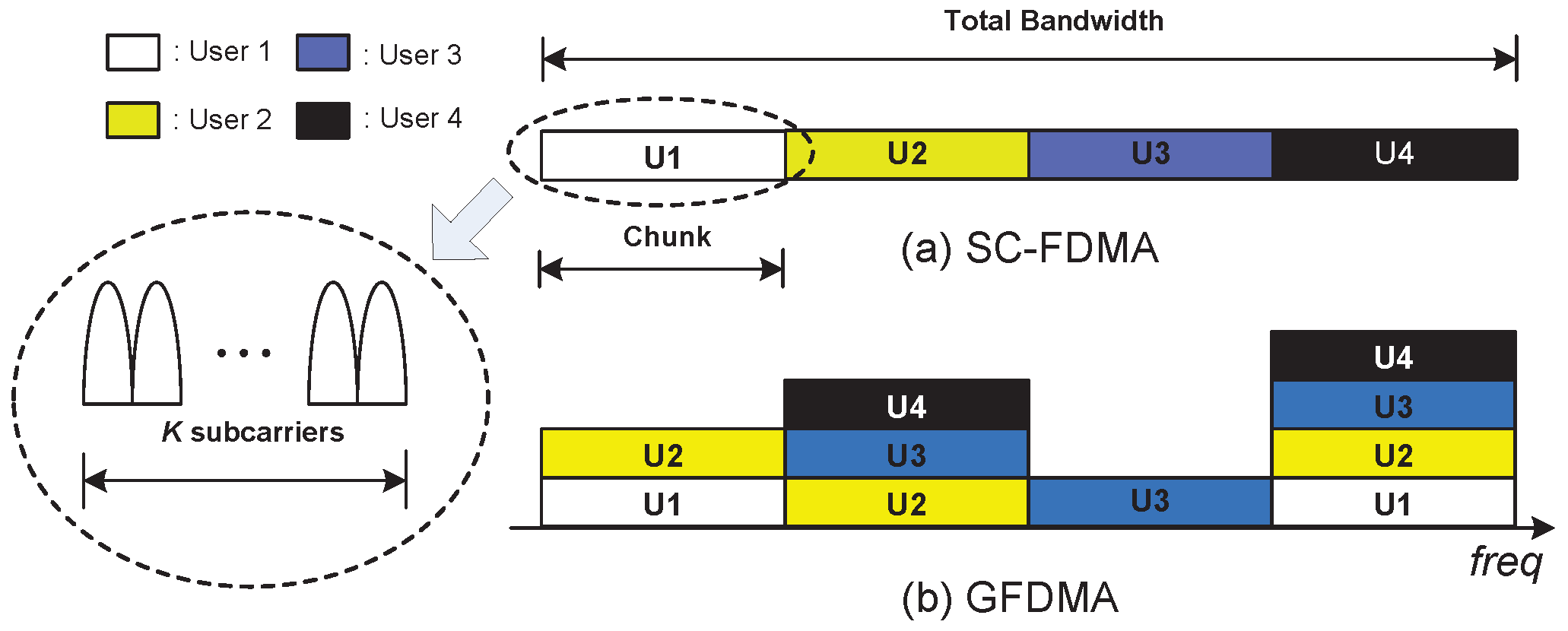


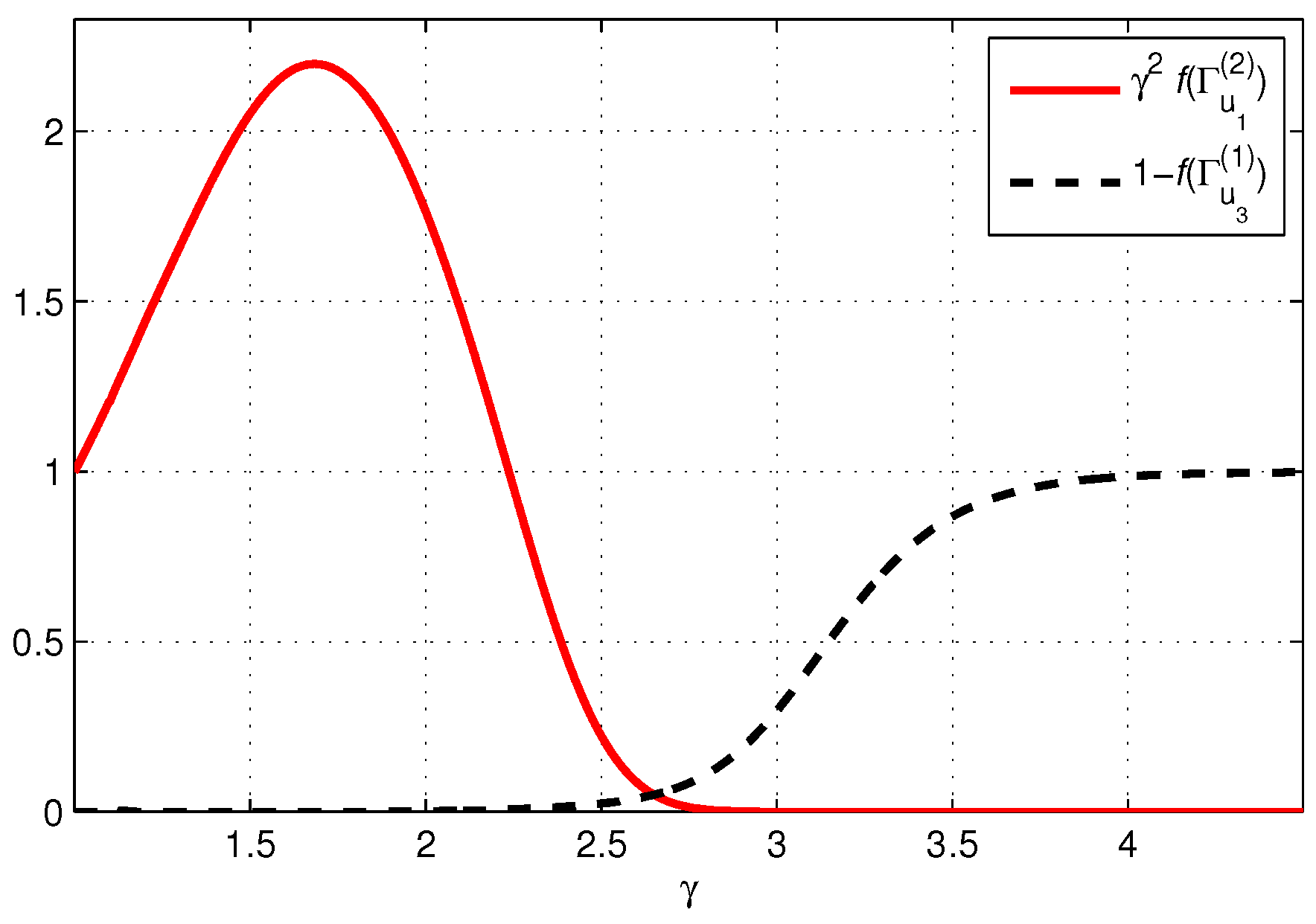
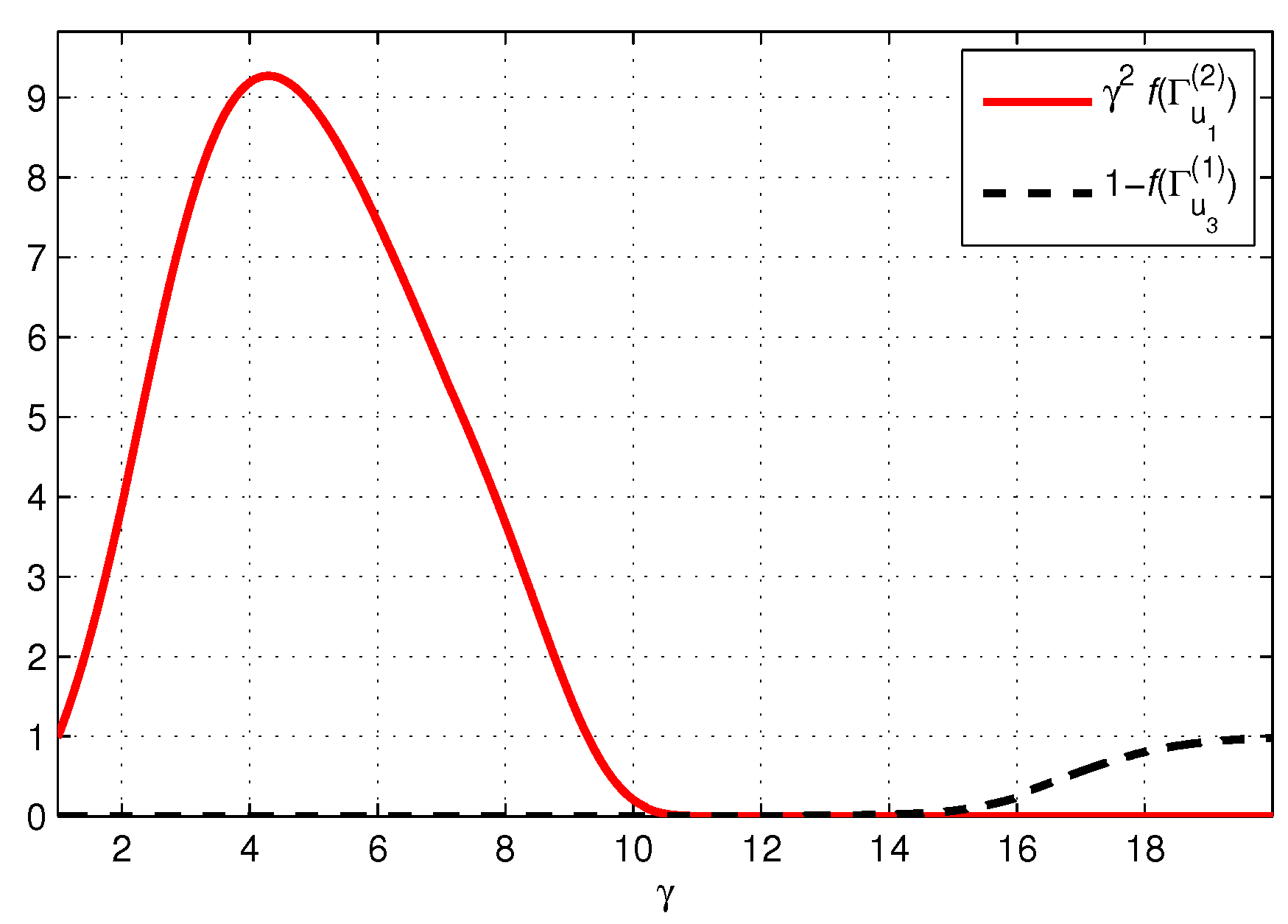
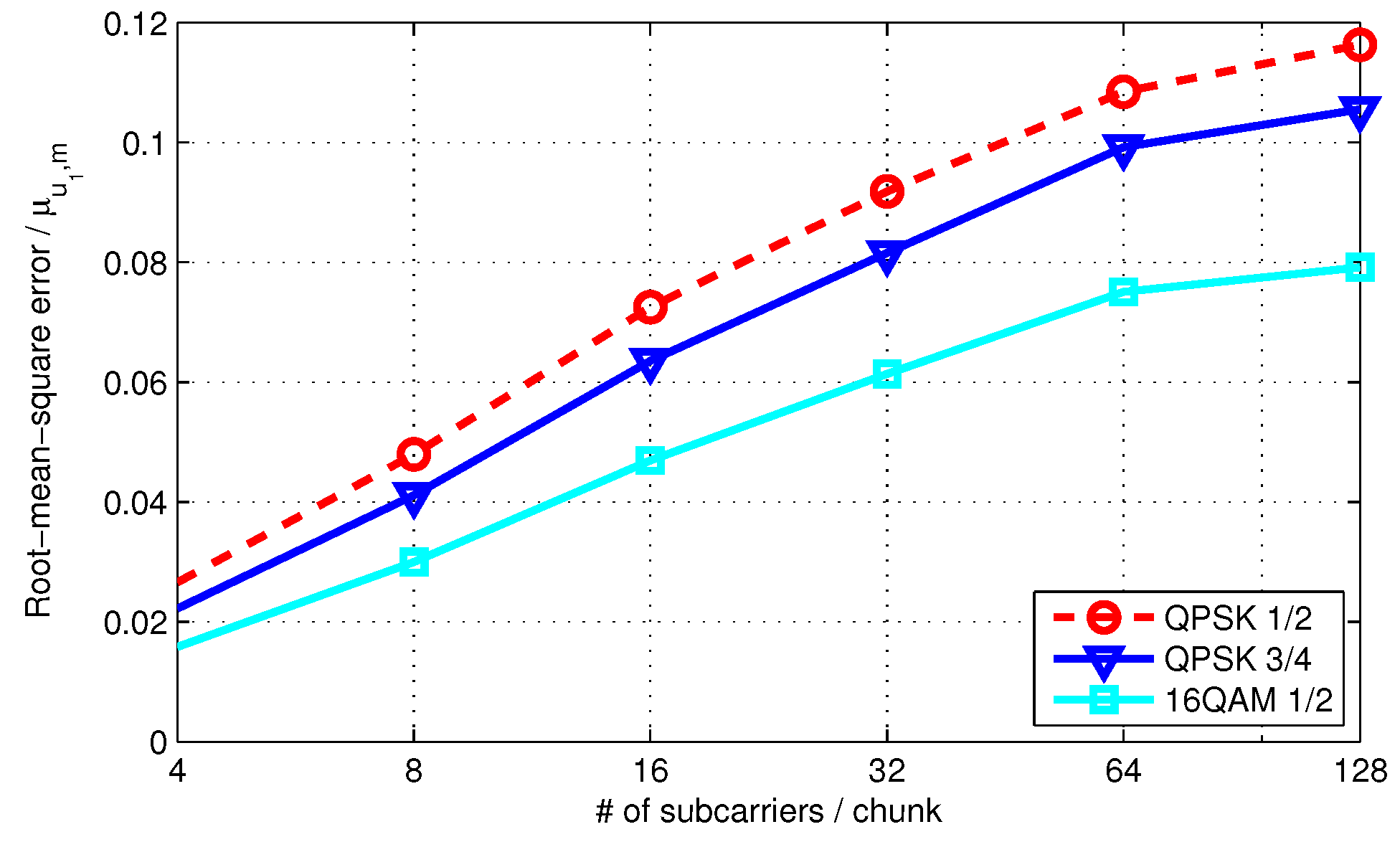
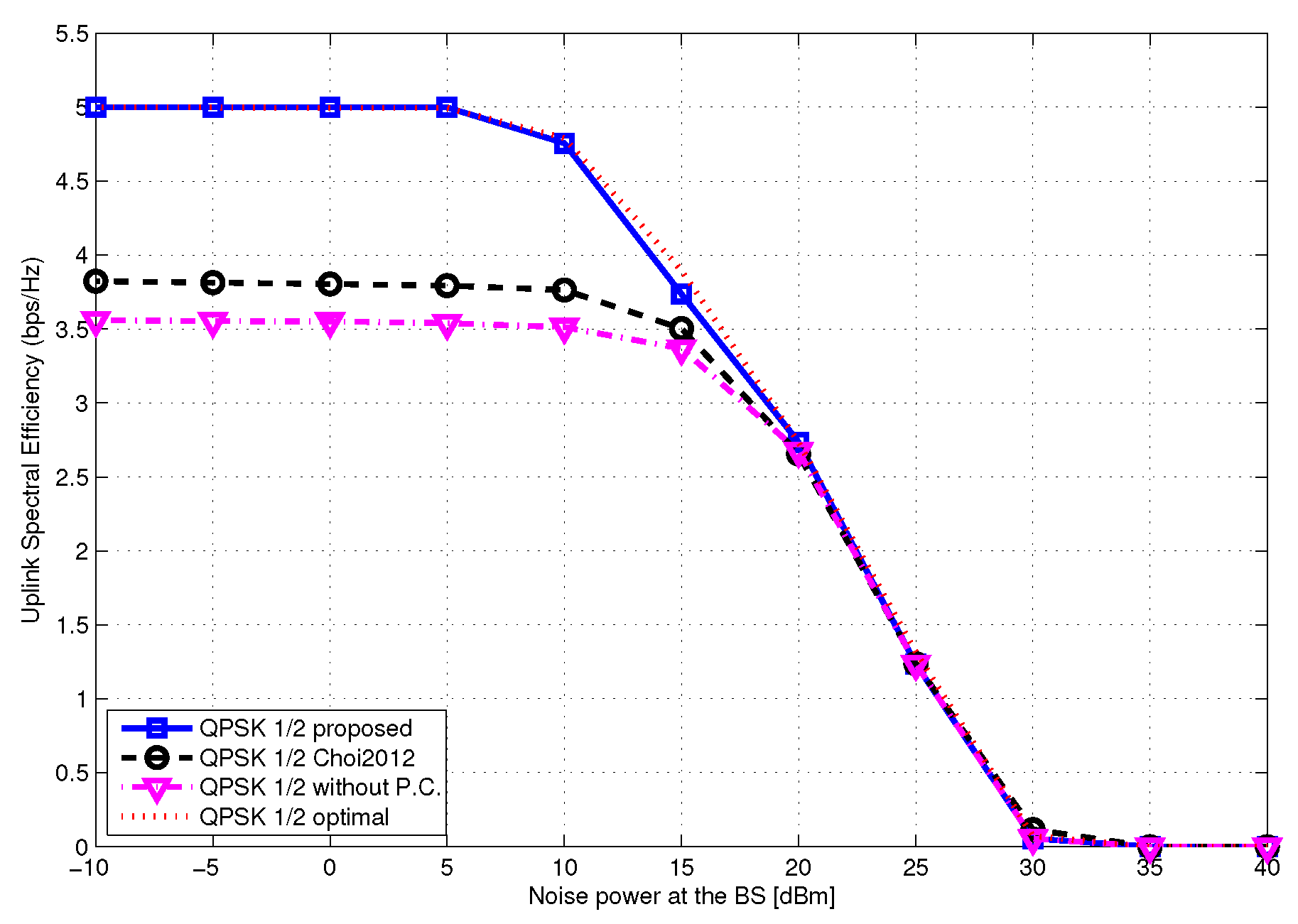
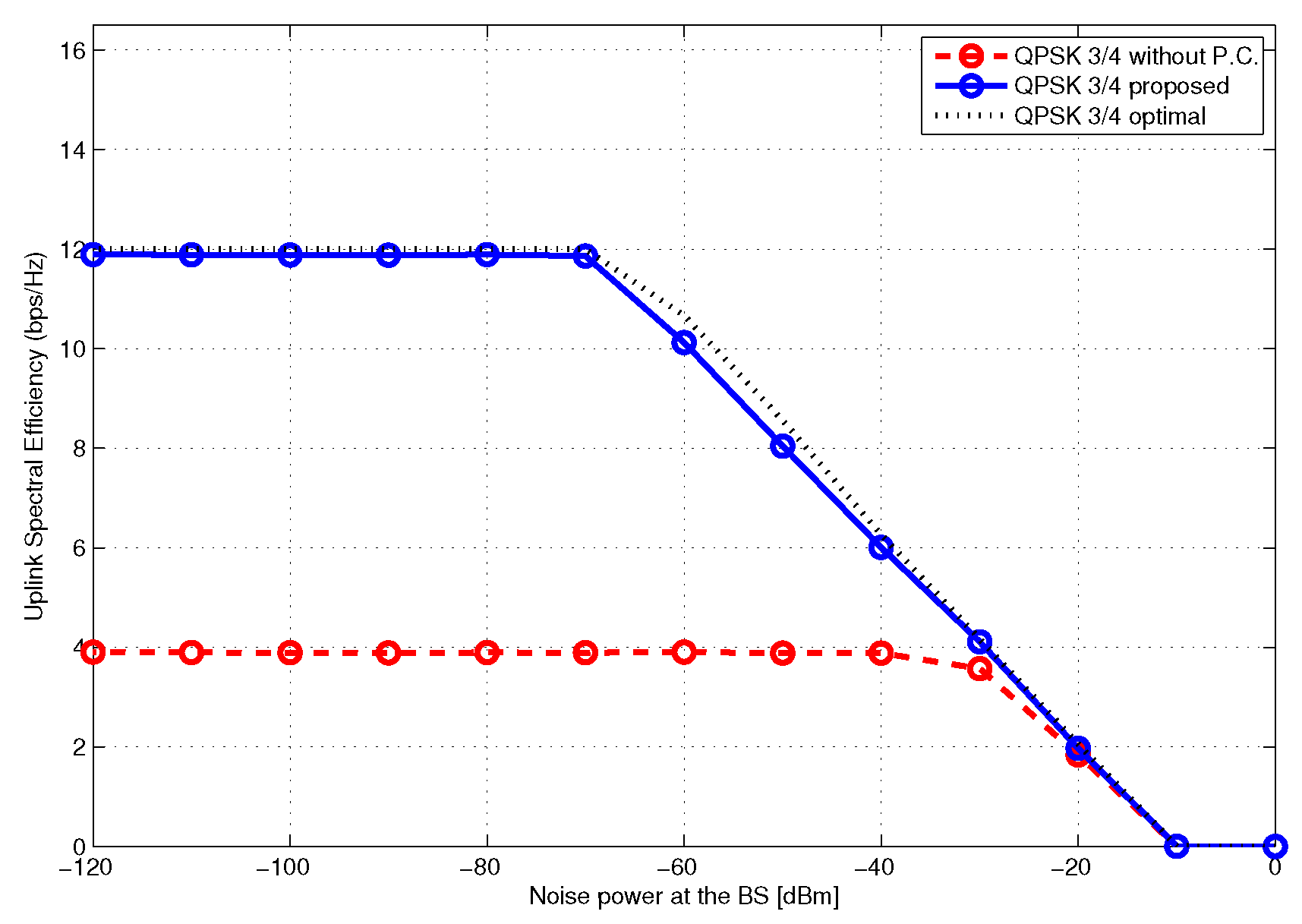

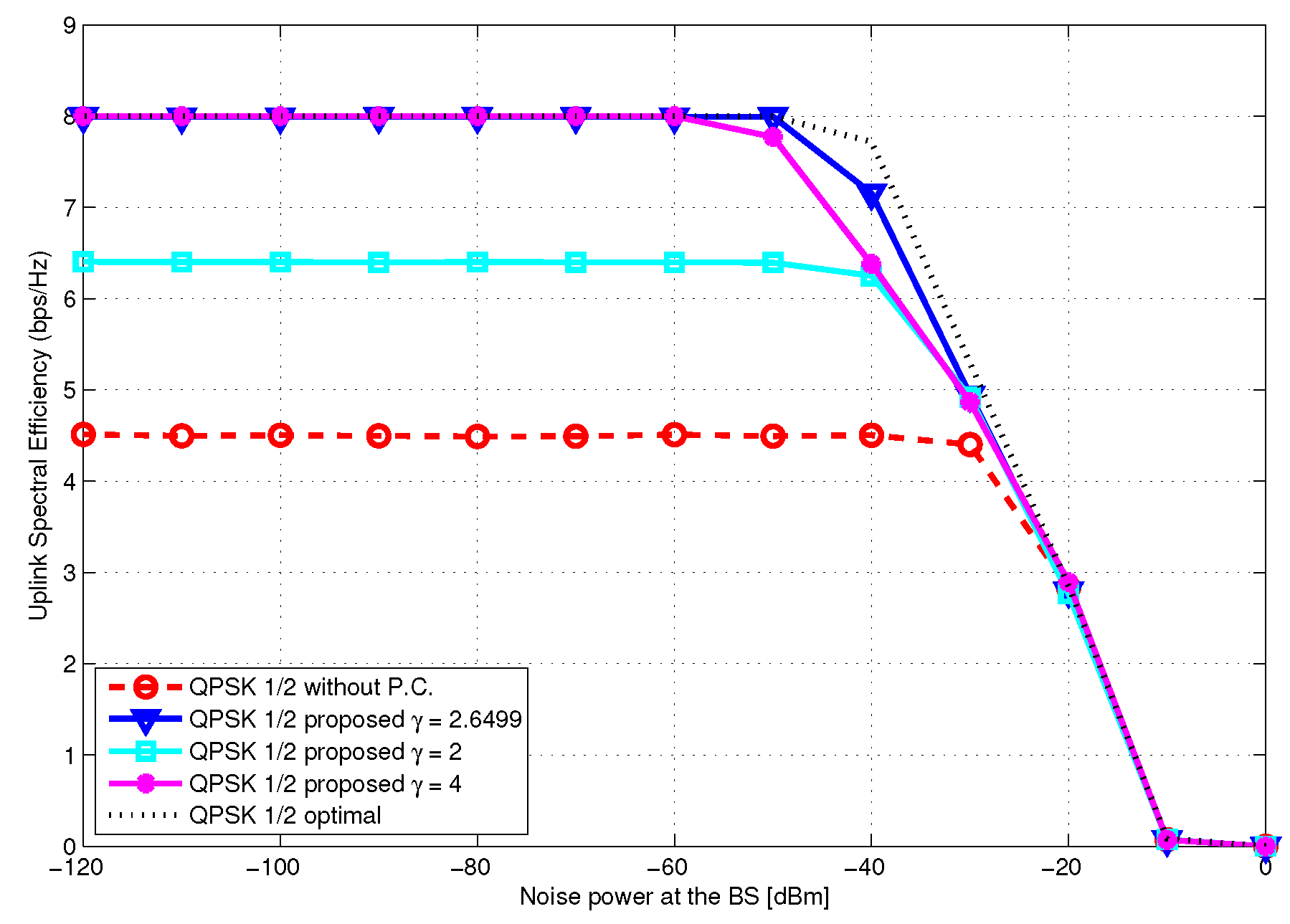
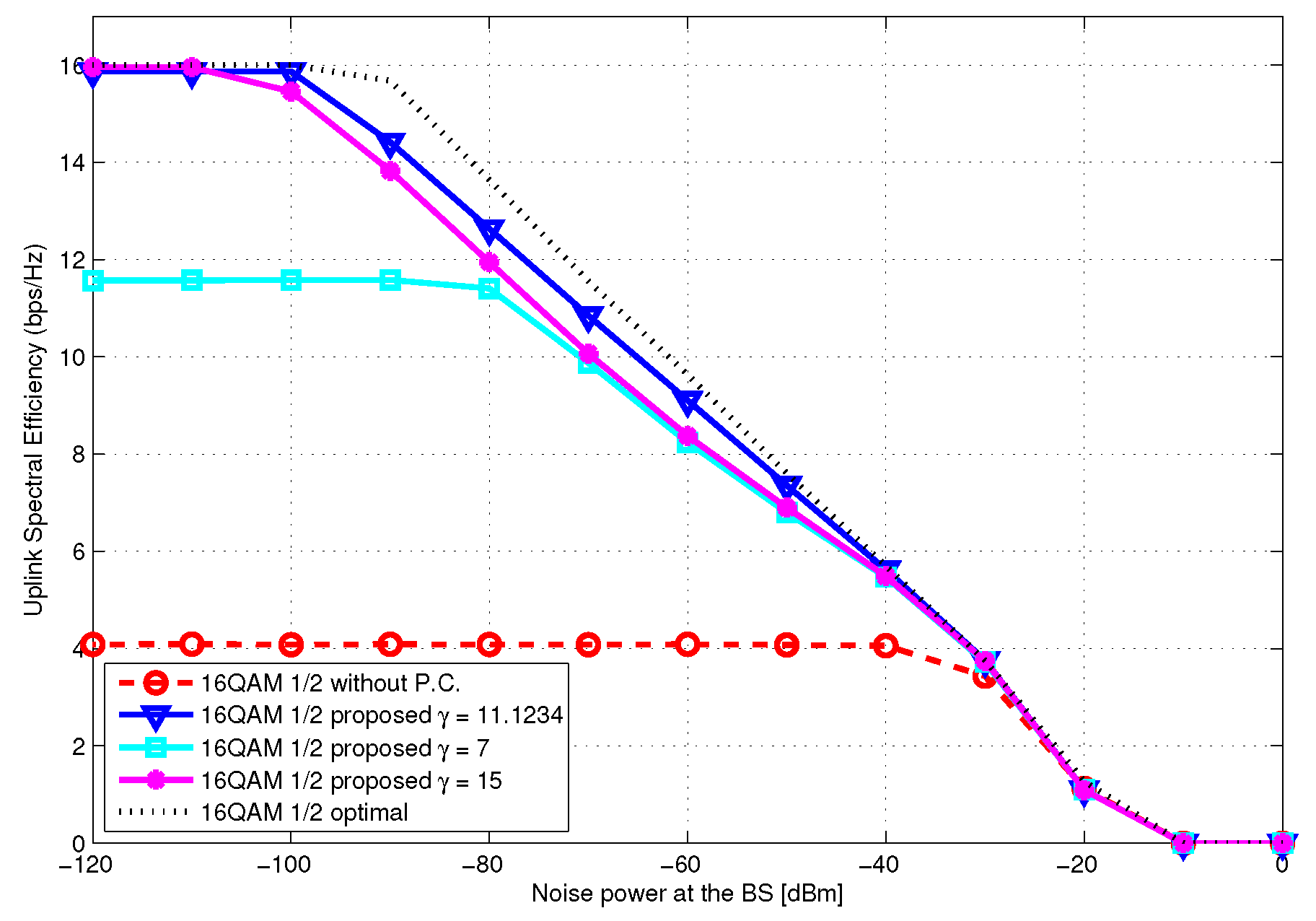
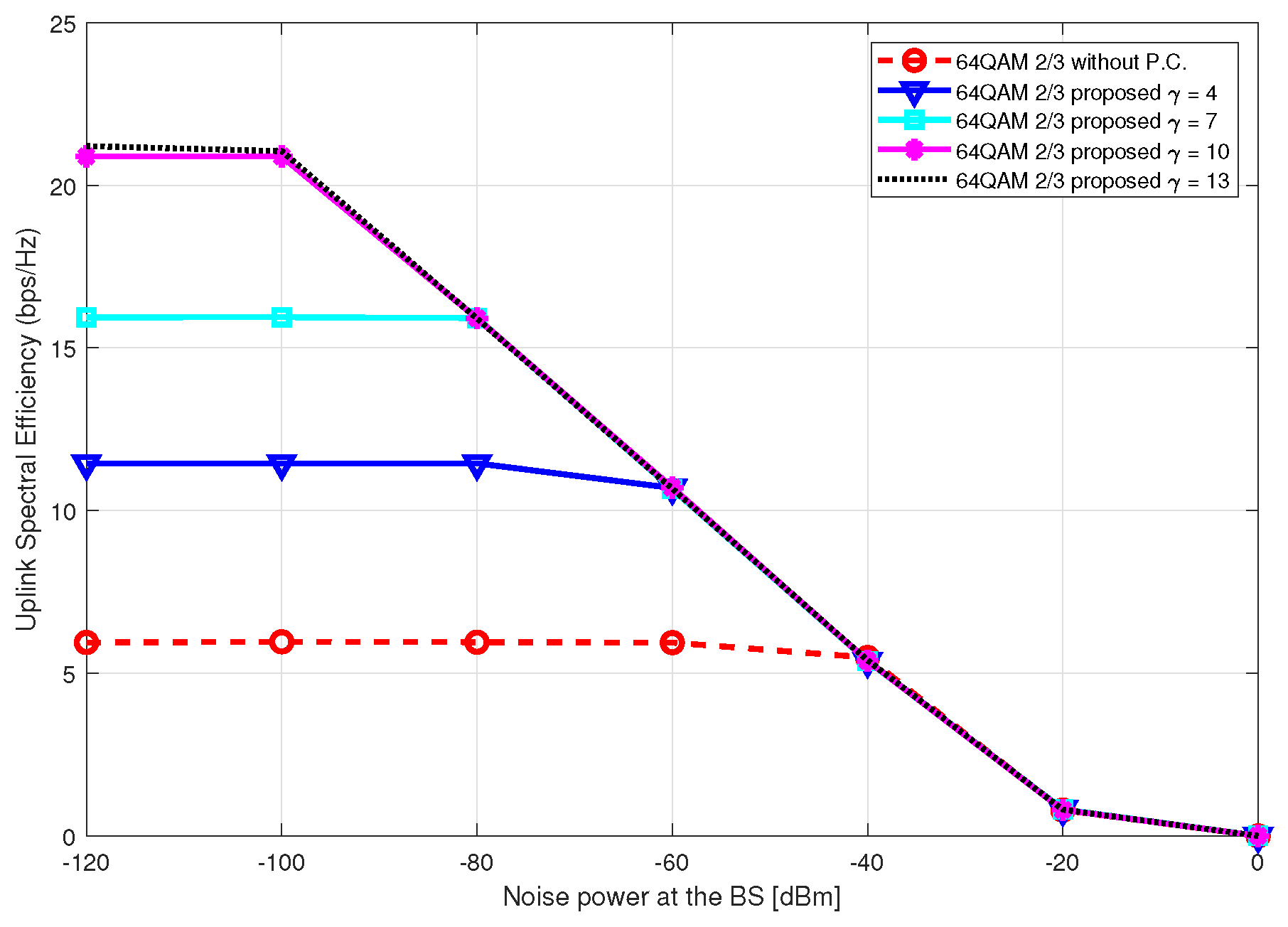
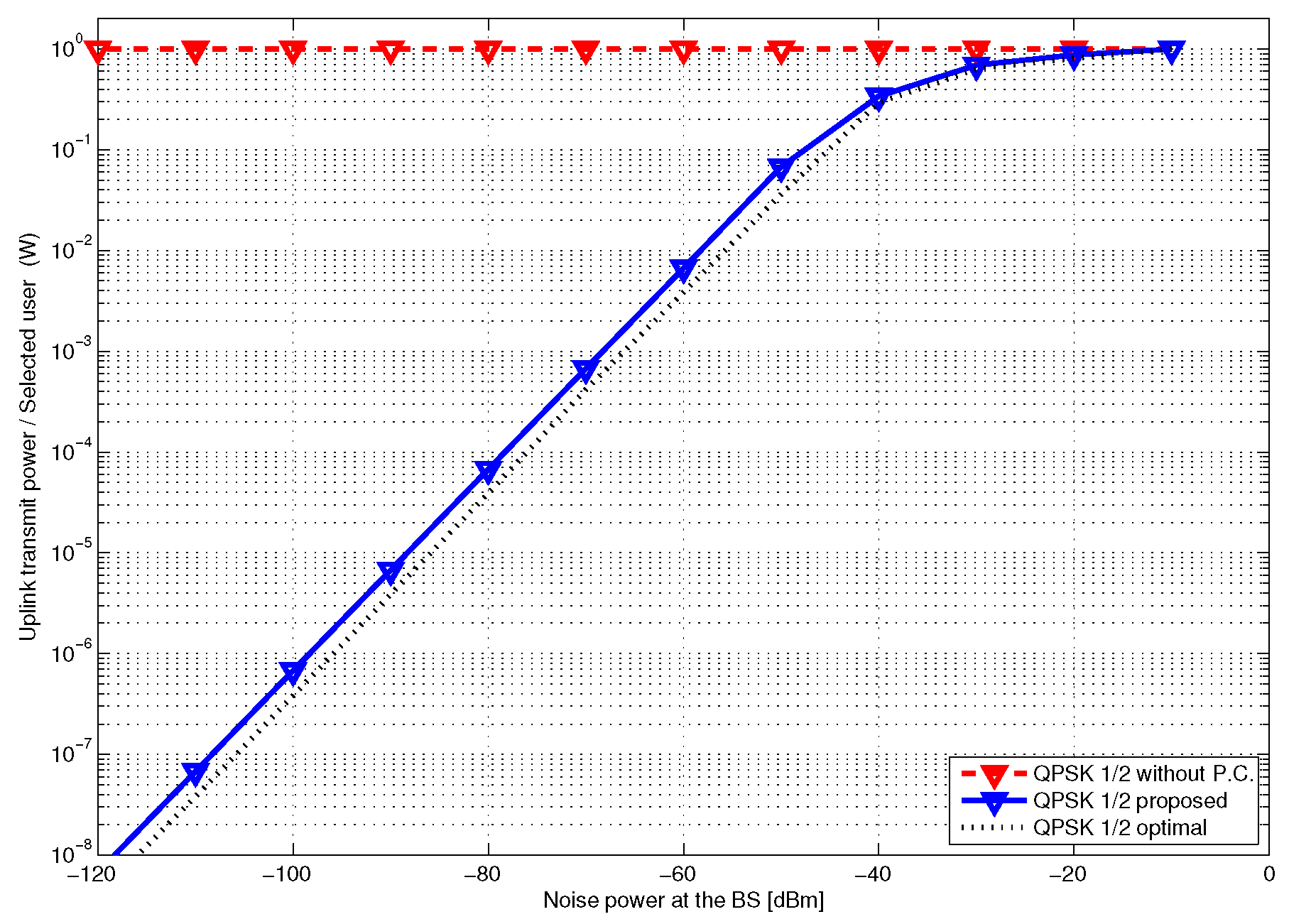
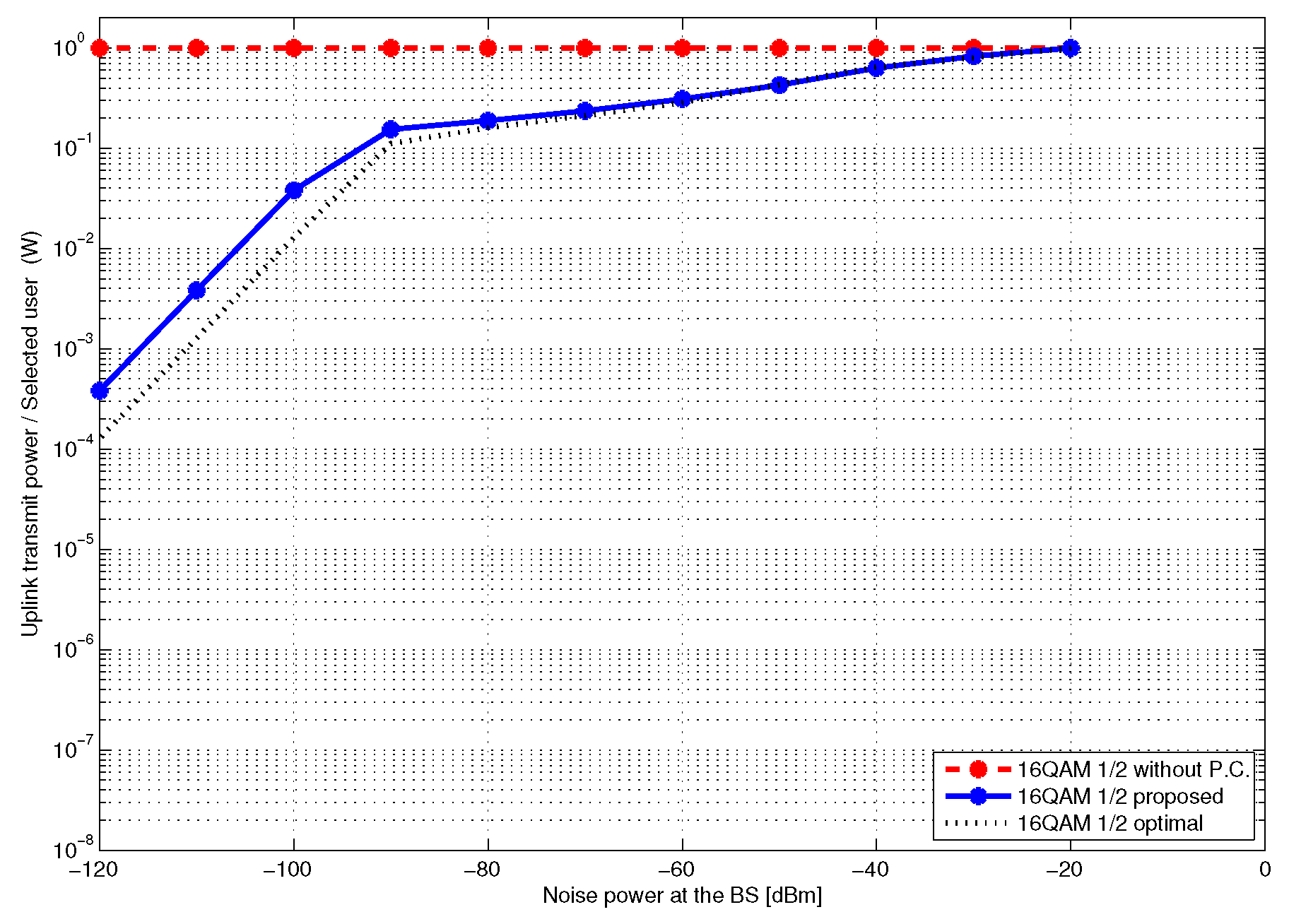
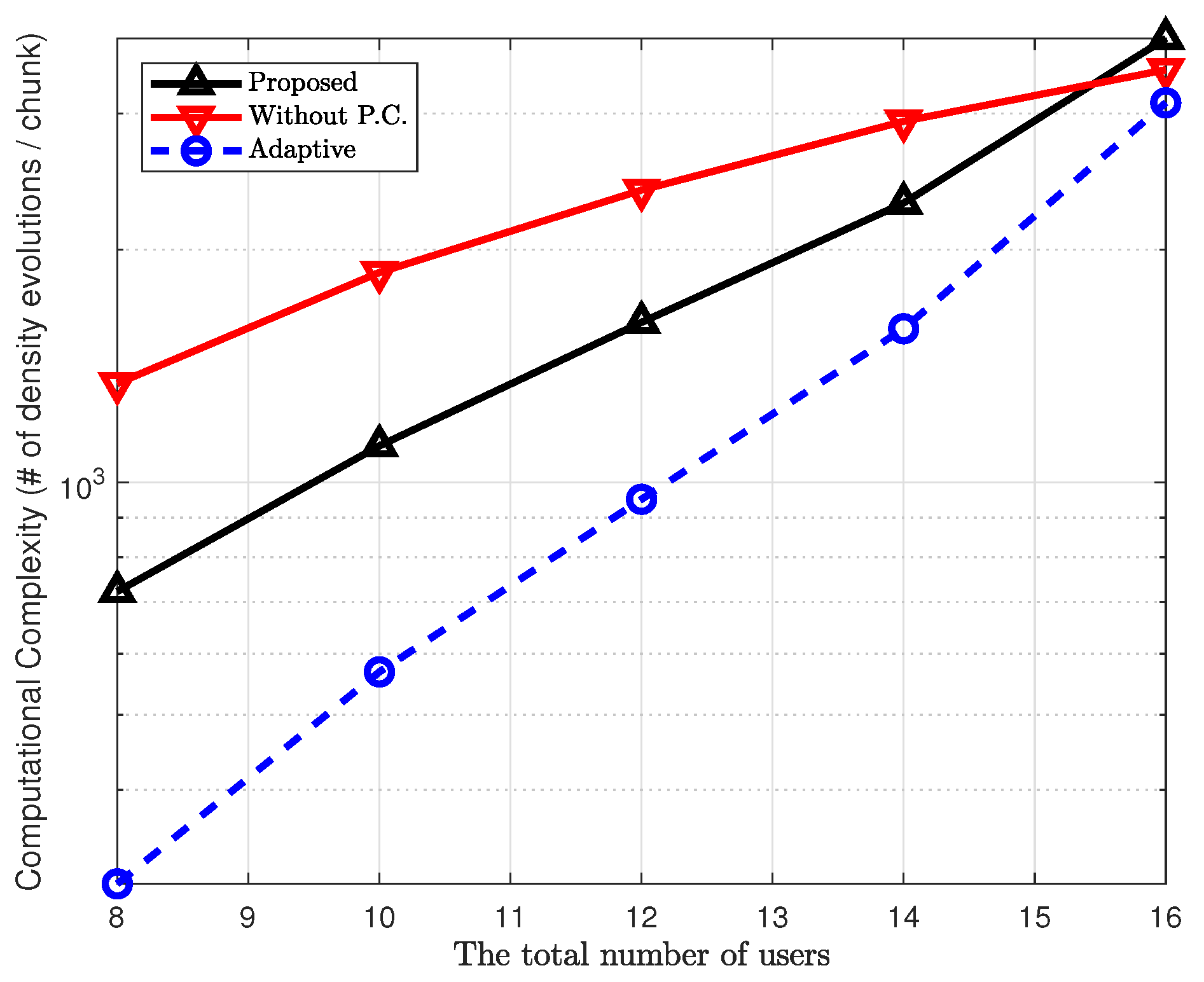
| M | Total number of chunks in frequency domain |
| N | Total number of subcarriers in frequency domain |
| K | Number of subcarriers in each chunk |
| Set of all users | |
| U | Total number of users: |
| Set of users allocated to chunk m | |
| Number of users in chunk m: | |
| Pathloss from BS to user u | |
| Transmit power of user u at chunk m | |
| Channel frequency response of user u at chunk m | |
| Estimated variance of the signal of user u at chunk m | |
| Estimated mean of the signal of user u at chunk m | |
| Estimated SINR of user u at chunk m | |
| Threshold of SINR for QoS constraint | |
| Spectral efficiency at chunk m | |
| Single-user data rate of user u at chunk m | |
| MCS | |
|---|---|
| BPSK 1/2 | 1.6467 |
| QPSK 1/2 | 2.6499 |
| QPSK 3/4 | 5.2155 |
| 16QAM 1/2 | 11.1234 |
| 16QAM 2/3 | 25.7521 |
| 16QAM 3/4 | 30.8445 |
© 2019 by the authors. Licensee MDPI, Basel, Switzerland. This article is an open access article distributed under the terms and conditions of the Creative Commons Attribution (CC BY) license (http://creativecommons.org/licenses/by/4.0/).
Share and Cite
Cho, Y.-S.; Kang, Y.-S.; Min, M. Uplink Transmit Power Control for Single-Carrier Grouped FDMA with Iterative Multiuser Detection. Appl. Sci. 2020, 10, 119. https://doi.org/10.3390/app10010119
Cho Y-S, Kang Y-S, Min M. Uplink Transmit Power Control for Single-Carrier Grouped FDMA with Iterative Multiuser Detection. Applied Sciences. 2020; 10(1):119. https://doi.org/10.3390/app10010119
Chicago/Turabian StyleCho, Yong-Sang, Yun-Seong Kang, and Moonsik Min. 2020. "Uplink Transmit Power Control for Single-Carrier Grouped FDMA with Iterative Multiuser Detection" Applied Sciences 10, no. 1: 119. https://doi.org/10.3390/app10010119





